Motorola Droid 3 Review - Third Time's a Charm
by Brian Klug on July 30, 2011 12:01 AM ESTPerformance Analysis
The next stop on our trip through the Droid 3 is of course its SoC, which is a TI OMAP 4430. This is our first formal encounter with OMAP4430 in a real, live shipping phone. Well, that’s not entirely true - we have an LG Optimus 3D in the queue as well which we’ll be talking about later.
The OMAP 4430 is based on two ARM Cortex A9s, each running at up to 1.0 GHz and with 1 MB of shared L2 cache. Unlike Tegra 2, however, OMAP 4 includes the ARM Media Processing Engine (MPE) instead of just the default A9 FPU, and thus allows OMAP 4 to execute NEON (SIMD) in addition to just normal VFP and VFPv3 instructions. It’s easiest to illustrate the difference simply by showing what looking at /proc/cpuinfo yields on each SoC:
OMAP 4: Features : swp half thumb fastmult vfp edsp thumbee neon vfpv3
Exynos: Features : swp half thumb fastmult vfp edsp neon vfpv3
Tegra 2: Features : swp half thumb fastmult vfp edsp vfpv3 vfpv3d16
MSM8260: Features : swp half thumb fastmult vfp edsp thumbee neon vfpv3
OMAP 3: Features : swp half thumb fastmult vfp edsp neon vfpv3
Careful readers will note that the other interesting differentiator is thumbee support, which to my knowledge isn’t used in Android currently. NEON, however, definitely is throughout the Android OS, including places like Skia (for drawing 2D graphics, text, and images), Chrome (web browsing, both for rendering, page layout, and the all-important V8 JavaScript engine), and Surfaceflinger (Android’s window system and compositor). Each Cortex A9 has an MPE onboard.
There’s also two Cortex-M3s inside OMAP4430, which do double duty for for OMAP4’s Imaging SubSystem (ISS). In OMAP4, that ISS comprises image signal processing (ISP) functions such as autofocus, exposure, white balance, and acting as a front end interface to any and all cameras, and secondly still image processing (SIMCOP) which includes functions such as actually coding the image out to JPEG, correction for lens distortion, and any noise filtering from running the sensor at a high ISO. One of the M3s handles SIMCOP, the other can divide itself between managing the realtime OS running both, the ISP functions for camera, or do some duty managing the display subsystem. Those M3s are also clock gated in sleep modes.
The next important part of the equation is OMAP4430’s GPU, which is a PowerVR SGX 540. What sets the SGX 540 in OMAP4430 apart from the other SGX 540’s we’ve seen to date (such as the one in Samsung’s Hummingbird S5PC110 SoC) is that it runs at a higher clock of 304 MHz compared to Hummingbird’s ~200 MHz. Back when OMAP 4470 was announced, I made this table:
| TI OMAP 4xxx SoC GPU Comparison | |||||||||
| OMAP4430 | OMAP4460 | OMAP4470 | |||||||
| GPU Used | PowerVR SGX540 | PowerVR SGX540 | PowerVR SGX544 | ||||||
| Clock | 304 MHz | 384 MHz | 384 MHz | ||||||
Alongside it I re-published the table that Anand put together back for our Tegra 2 piece with a more concise breakdown. We can see that though the GPU is still an SGX 540, increasing those clocks makes an obvious positive difference in performance.
| Mobile SoC GPU Comparison | |||||||||
| PowerVR SGX 530 | PowerVR SGX 535 | PowerVR SGX 540 | PowerVR SGX 543/544 | PowerVR SGX 543/544MP2 | GeForce ULP | Kal-El GeForce | |||
| SIMD Name | USSE | USSE | USSE | USSE2 | USSE2 | Core | Core | ||
| # of SIMDs | 2 | 2 | 4 | 4 | 8 | 8 | 12 | ||
| MADs per SIMD | 2 | 2 | 2 | 4 | 4 | 1 | ? | ||
| Total MADs | 4 | 4 | 8 | 16 | 32 | 8 | ? | ||
| GFLOPS @ 200MHz | 1.6 GFLOPS | 1.6 GFLOPS | 3.2 GFLOPS | 6.4 GFLOPS | 12.8 GFLOPS | 3.2 GFLOPS | ? | ||
| GFLOPS @ 300MHz | 2.4 GFLOPS | 2.4 GFLOPS | 4.8 GFLOPS | 9.6 GFLOPS | 19.2 GFLOPS | 4.8 GFLOPS | ? | ||
Hummingbird's SGX 540 thus gets around 3.2 GFLOPS, whereas the higher clocked SGX 540 in OMAP4430 is appropriately around 4.8 GFLOPS.
First up is Linpack which now includes a multithreaded test alongside its single threaded test. There was originally some debate internally about whether this version of linpack from the Android market was using NEON or just VFP, the results now speak for themselves, it’s entirely just VFP.
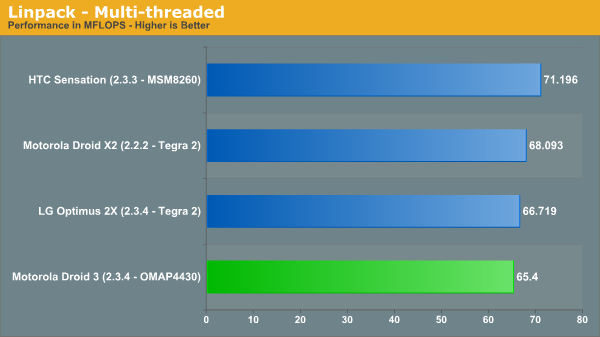

Next are RightWare’s Basemark ES 2.0 which is the latest version of the ever popular 3DMark Mobile ES 2.0, itself an industry standard. The test has two main tests and then a variety of subtests, and Adreno 220 maintains a lead here over the faster SGX 540, but we can see already how much that extra ~100 MHz advantage helps the Droid 3 over the Droid Charge’s Hummingbird (A8 + SGX 540 at 200 MHz). We run at the same VGA resolution here so the results are comparable despite the different display sizes.
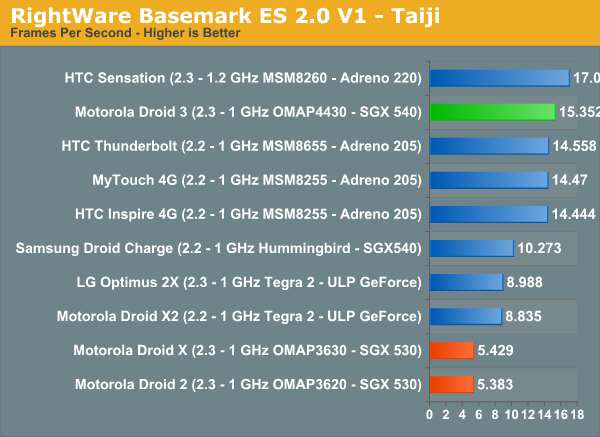
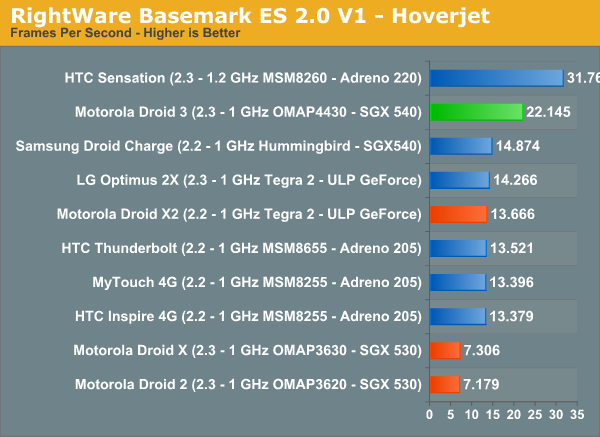
The ever popular GLBenchmark 2.0 is also an industry standard and a regular fixation in our smartphone benchmarking section, and the Droid 3 results mirror what we saw both way back when the device popped up online in the results browser and our initial testing two weeks ago with the phone. GLBenchmark runs in full screen mode, so keep in mind the qHD versus WVGA discrepancy when comparing results. We can easily again see that the higher clocked OMAP4430 SGX 540 changes things up nicely.
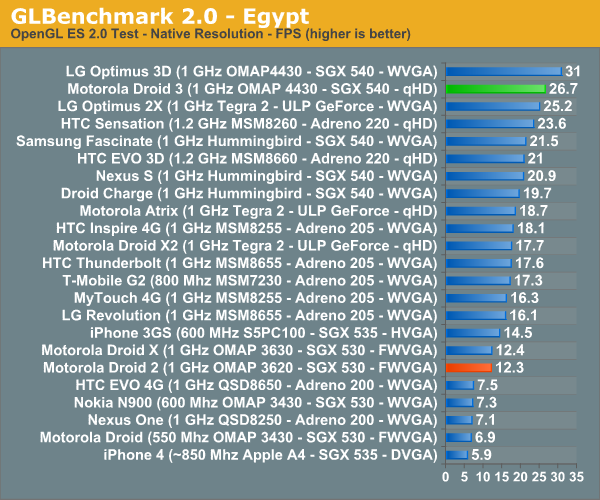
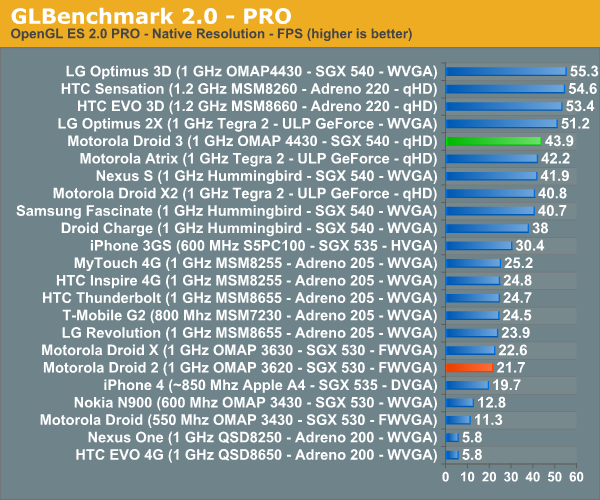
Next up is what started it all for us, the Quake 3 Android port “kwakk3” which is starting to show its age and is basically at the FPS cap on newer devices with newer GPUs. We’ve kept it around for the Droid 3 however just to illustrate how quickly things like this have gone from being almost unplayable a year ago to fluid on modern hardware. Anand keeps saying hyper Moore’s law, and this is just one more data point you can point at as supporting that hypothesis.
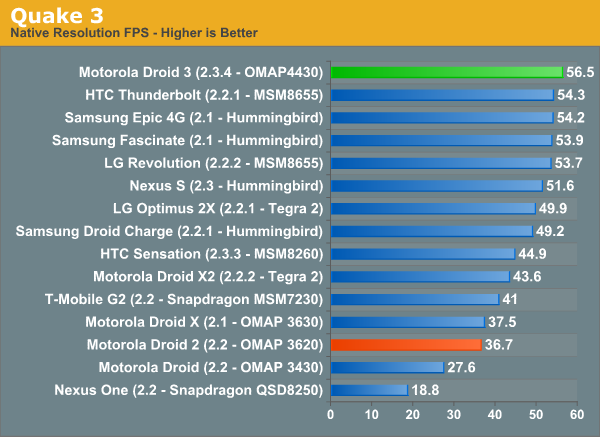
Finally are the two web benchmarking suites, SunSpider 0.9 and RightWare’s Browsermark. We’re running 0.9.1 and will migrate to that soon, but for now the results from 0.9 are still comparable. Remember that V8 does have some NEON codepaths, so we do see OMAP4 pull ahead of Tegra 2 just by a sliver on both tests.
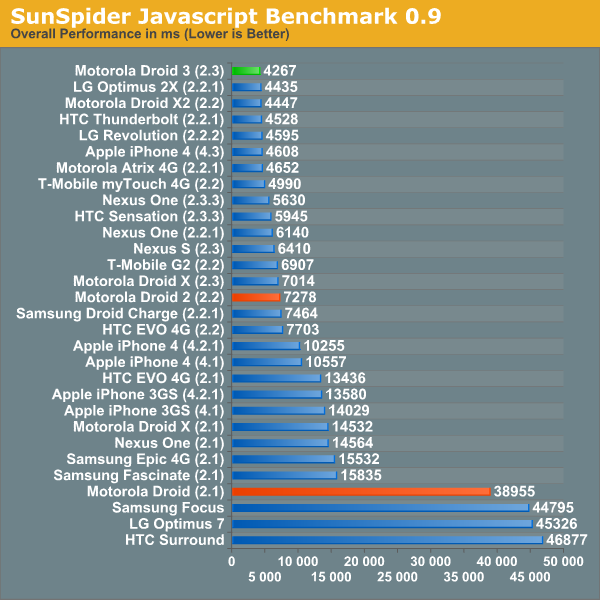
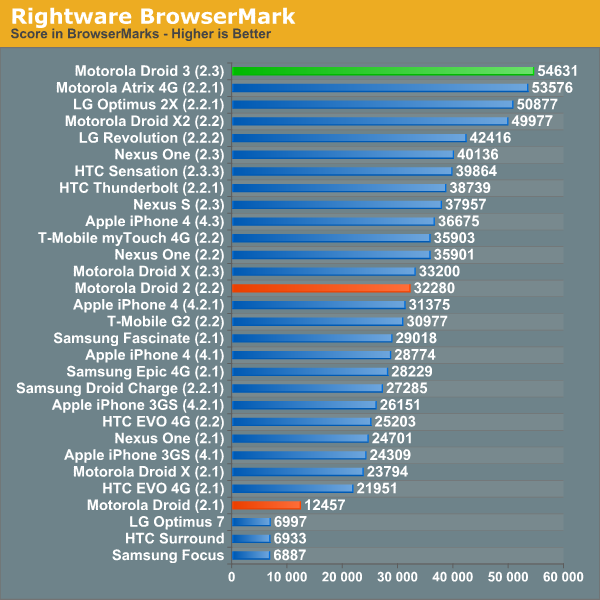
We’re going to start reporting Qualcomm’s new Vellamo benchmark results after we further understand all of its tests and how it calculates results, but we’re running it silently on devices. Until then however, browser scrolling performance (one of the things it does purport to gauge) is still probably the largest and most perceptible performance issue.
I’ve put together a short comparison video showing the Droid 3 alongside a Droid X. I don’t have a Droid 2 on hand anymore, but the X is a decent facsimile both because it has the same resolution as the Droid 2, is running Android 2.3.3 (which the Droid 2 has yet to get but will shortly) and still is based on a 1 GHz OMAP3 (3630 vs 3620).


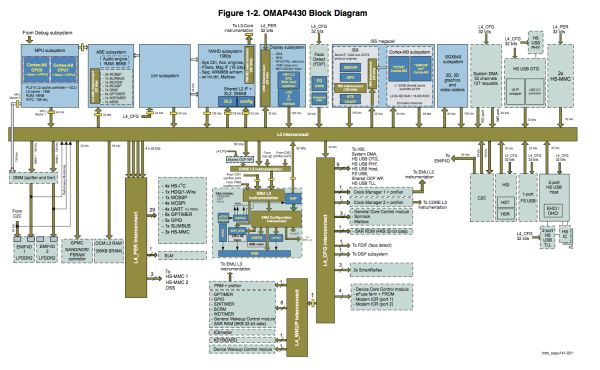
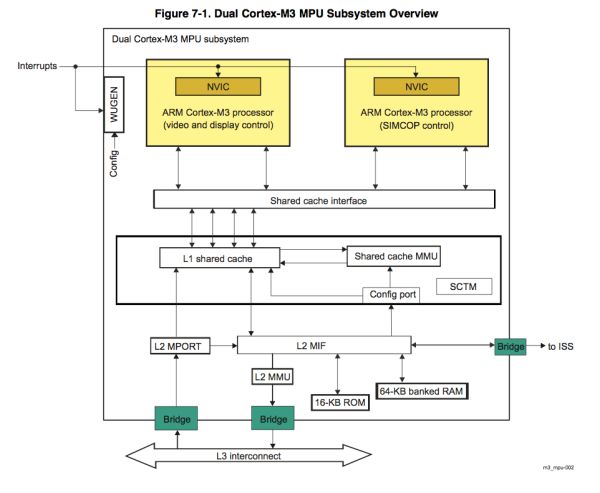








84 Comments
View All Comments
EndlessChris - Saturday, July 30, 2011 - link
Great review as always. Looks like this will be my new phone :)RaistlinZ - Saturday, July 30, 2011 - link
Sharp lookin' phone. I like.vol7ron - Sunday, July 31, 2011 - link
I like this too, larger screen, nice looking keyboard, great looking device. It seems to have it all.One thing, does it really have a 0.3MP front-facing camera? I would suspect 1.3MP would be more realistic, especially since there are probably economies of scale for that technology right now.
Thx,
vol7ron
Brian Klug - Friday, August 5, 2011 - link
Vol7ron,It definitely does have a 0.3 MP (VGA) front facing camera. http://developer.motorola.com/products/droid-3-xt8...
I'd like to see 1.3 MP sensors on the front for sure, but at this point it doesn't make sense until both the per-pixel quality is the same (same size pixels) and there are apps that can actually do some HD teleconferencing (like if Skype had support). We're almost there though.
-Brian
Myrandex - Monday, August 1, 2011 - link
It would be for me if it wasn't for this bastardization that Verizon did:The obvious next part of the story is that WCDMA HSPA+ 14.4 Mbps connectivity. Unfortunately, Verizon has locked the retail Droid 3 out of seeing USA-based GSM/WCDMA networks with an MCC (Mobile Country Code) lock.
Why can't Verizon just allow the hardware to perform at its fullest rather than finding some way to lock it down? They have always been terrible about locking their phones in some way.
Jason Cook
themossie - Saturday, July 30, 2011 - link
Tried the Droid 3 in store the day it came out, mixed feelings about the screen.Found it very usable for applications, not usable for serious reading (news, ebooks, etc). First time I've suffered eyestrain from an LCD screen with decent brightness and contrast. Droid 1 works great for this use case.
Brian, Anand and the rest of the AnandTech team - any opinions on this? Anyone else?
themossie - Saturday, July 30, 2011 - link
Also, thanks for the great review - business as usual at Anandtech!steven75 - Saturday, July 30, 2011 - link
Indeed. Can't believe he tried to equate this pentile display with less resolution in a larger screen size (significantly worse PPI) with the retina display. They aren't even close.bplewis24 - Saturday, July 30, 2011 - link
I'll trust the guy who looks at hundreds of phones per year over the hyperbolic masses who troll the internet.I'll also trust my own eyes and science, which prove you wrong.
Finraziel - Sunday, July 31, 2011 - link
Well, I'll also trust my own eyes, and the picture right above where Brian says he doesn't mind pentile too much really makes the droid3's screen look like crap compared to the lower resolution droid2 right next to it. My experience with other pentile screens also suggests there's absolutely no point in increasing the resolution only by using a trick like this, you end up with noticably lower effective resolution. I'd prefer an actually sharp screen over impressive specifications.I really hope when the 720p screen phones come out in the next half year or so they wont be using cheap tricks like this.